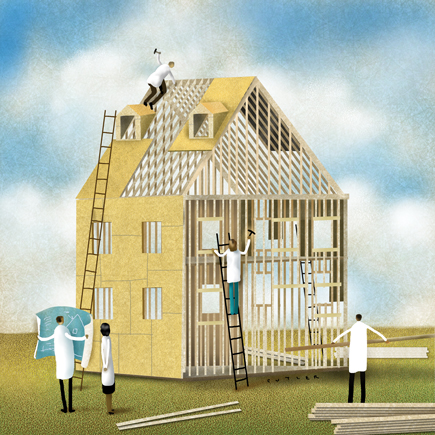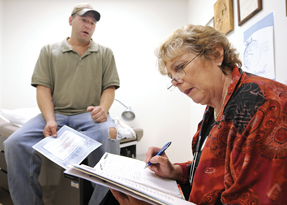Building the medical home starts in school
Four medical schools revamped their residency programs to include concepts of the patient-centered medical home. The changes resulted in teamwork, continuity of care, and more intense clinical rotations.
At the University of Nebraska, residents look forward to going to clinic. At Danbury Hospital in Connecticut, an increasing number of U.S. medical school graduates are choosing residencies in internal medicine. At Tulane University in New Orleans, residents are following up on outpatients' test results even when they're not in the clinic.
And at the University of Cincinnati, residents are sad at the end of their primary care rotation. “It can be a rather poignant moment when you leave that patient panel,” said ACP Associate Member Justin Held, MD, a chief resident at Cincinnati. Hearing this statement, leaders of other residency programs might find themselves a little teary-eyed, too, with jealousy.

All four programs have revamped their residency clinics in an effort to implement the patient-centered medical home, a concept developed by ACP and other organizations to improve patient care. The patient-centered medical home calls for patients to have an established relationship with a primary care physician who coordinates and oversees comprehensive, continuous care.
“Because there has been widespread support of the tenets of the patient-centered medical home by parent organizations in all the primary care disciplines, it's a natural trickle-down to think about how to better prepare primary care doctors in training,” said Scott Shipman, MD, director of primary care affairs for the Association of American Medical Colleges.
Preparing these future primary care physicians and improving care for current patients of residency clinics at the same time has posed both benefits and challenges, program leaders said. But they agreed that the changes have been worthwhile and should be considered by other primary care practices and training programs.
Scope of change
Converting to a medical home doesn't have to be an all or nothing proposition, the program leaders noted. While the Cincinnati and Tulane clinics have been certified by the National Committee for Quality Assurance as medical homes, the other two programs have not.
“The residents are developing the model along with us,” said ACP Member Dino Messina, MD, PhD, clinical assistant professor at the University of Vermont and program director at Danbury. “We're not even sure what our final medical home product will look like.”
“We didn't want to wait until we had that certification,” agreed Thomas G. Tape, MD, FACP, professor and chief of internal medicine at Nebraska. “We think it's important but we thought it was more important to start doing the work.”
The work that these programs have done to become closer to medical homes varies, but some common themes emerge. First among them is teamwork. “It's why people don't like primary care. They don't have help,” said ACP Member Eboni Price-Haywood, MD, co-executive director of community health centers at Tulane.
Under the new models, residents get more help from non-physician providers, including nurses, pharmacists, diabetic educators and others, said Eric Warm, MD, FACP, associate professor and program director at Cincinnati.
“We have this whole group of people along with our nurses that are all responsible for our patients, and we work together to make sure their care is complete,” said Dr. Warm. The Nebraska program, for example, has devoted space for a social worker and a behavioral health specialist.
The programs also try to encourage a sense of team among physicians. “We changed our schedule around so that [the residents] are on fixed days with the same attending and they work in teams,” said Dr. Messina. “The resident always works with the same attending. If the resident is not available to see their patient panel, then there's a backup resident in this team.”
A sense of teamwork is reinforced at the Cincinnati clinic by team meetings every Monday afternoon. “Although not every resident comes every time, we have lots of the residents most of the time and the team meeting goes over the operations of the practice and the quality. I could never do that in the traditional model,” said Dr. Warm.
At some of the programs, residents' schedules have been changed to facilitate the team approach and greater continuity of care, a major goal of the patient-centered medical home. The Tulane program separated residents' outpatient time from their inpatient service, so that they would not have conflicting duties.
At Danbury, where the program is exclusively for physicians going into primary care, the residents spend their last six months practicing regular, full-time primary care. The Cincinnati program puts residents in the clinic providing ambulatory care from their 17th to 29th months.
Tools of the PCMH
Whether or not they've restructured schedules, the programs have also found other ways to increase residents' responsibility and patients' continuity. Electronic medical records (EMRs) and the team approach have helped with this effort.
Residents can check on ambulatory patients' records from outside the clinic and receive e-mail notifications about new developments, such as lab results. Better electronic communication improved continuity of care for the patient, integrated the resident more into the team and enhanced clinic staff's confidence that they could communicate with the primary care clinician, said Dr. Price-Haywood.
The Nebraska program found limitations in its EMR's ability to identify the primary physician, so a workaround was developed to accomplish the same goal. Sue Burbach, the clinic's medical home coordinator, can now find a patient's physician in a database and contact that resident by phone or e-mail. This maintains continuity, keeps residents in the loop and ensures that residents are still driving the decision-making process, Dr. Tape said.
And attending physicians who are responsible for those residents can also use the same system to assess the quality of the residents' decision making, said Dr. Price-Haywood. The assessment goes hand-in-hand with the disease-based patient registries that are a major component of the medical home model. This is a significant change in the educational process, as well as in clinical care, noted Dr. Warm.
“When I was a resident, I never once received a single report about my care. I never once knew how my diabetics were doing or had any patients tell me how they thought I was doing,” he said.
Some of the medical home residents have also worked on team efforts to improve their patients' health. The Nebraska residency clinic started diabetic nutrition classes in a new kitchen built for that purpose, and developed standardized forms for outpatient encounters and inpatient discharges, among other innovations.
“We've implemented what we call a birthday visit, where you bring in the patients for 40 minutes and you touch on current medical status, reconcile medications, bring health care maintenance up to date, assure there is a plan in place as they age and a plan for end of life,” said Ms. Burbach.
Results
Any effects of the innovations on patient care will take time to appear, but the programs have already succeeded in changing the experience of residency, according to those involved. “I don't know if what we do is perfectly indicative of the real world,” said Dr. Held, the Cincinnati chief resident. “I do think that with the constraints of a residency model, our ambulatory training gets much closer to real life.”
Program leaders hope that the medical home residency will make real-life primary care a more appealing career option. “The idea is ... that they are acculturated in that practice. They are away from the hospital for so long they don't want to come back,” said Ramin Ahmadi, MD, MPH, FACP, chair of medical education and research at Danbury and a founder of the PCMH residency program there.
The programs have shown success at luring residents, but that's not a guarantee that the ranks of primary care physicians will be increased, other program leaders cautioned. “We have definitely attracted residents in the past five years because of this, but until the world changes and everyone wants to do this work, that's not the only reason people come to our program,” said Dr. Warm.
Dr. Shipman offered more specifics on those needed changes. “Something's going to have to change in terms of how health care is financed to really allow the patient-centered medical home to take off. Then we will see primary care providers practicing in patient-centered medical homes really having a much more fulfilling and rewarding day-to-day existence and trainees will see that and aspire to it,” he said.
Proving value
Finances are also one of the major obstacles to implementation of the medical home residency. “Why isn't everybody doing this?” asked Dr. Tape. “The big elephant in the room is money. Who is going to pay for the pharmacist, the social worker, the dietician, the diabetes nurse educator, etc.?”
The programs have found various solutions to the money problem. The Danbury residency uses funding from a government (Health Resources and Services Administration) grant. At Nebraska, the hospital and various departments have contributed resources.
“Our hope is that we can eventually demonstrate our value to the various constituencies so they don't look at this as ‘We're giving away this service to the internal medicine residency clinic,’ but rather that ‘We're investing in something that gives us a good return,’” said Dr. Tape.
The programs face other ongoing challenges. “The EMR system that we have now is not adequate. You need to create a registry of patients and data. At present we're having difficulty trying to work that out,” said Dr. Messina. Training non-physician providers to do work previously handled by physicians has also been a challenge. In some programs, subspecialists have protested the devotion of resident time to primary care.
These hurdles could be discouraging to other potential innovators, noted Dr. Shipman. “The biggest concern I have is that the power of inertia will make it difficult for programs to adopt significant changes toward new models of care,” he said.
Start small
The advice of physicians who have been there should be reassuring, however. “It's an evolution. You don't have to bite off the entire chunk all at once,” said Dr. Tape. “We picked the low-hanging fruit … There are a lot of things that are good proactive medicine that you can do whether or not you have every last piece of a medical home in place.”
Dr. Price-Haywood offered an example. “Having a multidisciplinary team shouldn't be that complicated … That's something that should be immediately modeled in most places,” she said.
Dr. Warm agreed. “If I were starting over with another residency, I would focus on team first, and IT [information technology] as a second necessary but not sufficient part,” he said.
And conveniently, new potential team members are emerging from medical schools every year. Andres Espinoza, MD, is in his first year in the Danbury primary care track. “I believe that the transition's going to be a little difficult. But I'm willing to be part of this new idea and I remain optimistic that through innovative ideas and cooperative team efforts we will succeed,” he said.




